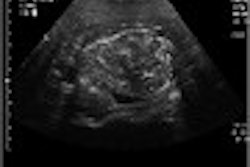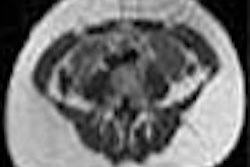Functional MRI can detect changes in tumor microvessels after two cycles of neoadjuvant chemotherapy in primary breast cancer, making it a useful management tool, according to a British study presented at the 2003 American Society of Clinical Oncology meeting in Chicago.
However, pre-treatment MRI does not predict response, said lead investigator Dr. Mli-Lin Ah-See, a clinical research fellow at Mount Vernon Hospital in Northwood, Middlesex. In an interview with AuntMinnie.com, Ah-See said the goal of the preliminary study was to "determine if we could identify early responders by targeting vascular changes. We think our results demonstrate that this is feasible."
Ten patients with primary breast cancer were scanned prior to and following two cycles of neoadjuvant chemotherapy (5-fluorourcil 600 mg/m2, epirubicin 60 mg /m2, and cyclosphamide 600 mg/m2 every three weeks) using a 1.5-tesla Symphony scanner (Siemens Medical Solutions, Erlangen, Germany). Initial T1- and T2-weighted anatomical scans were performed to select an imaging plane through the center of the tumor.
A bidimensional measurement of the tumor region of interest (ROI), defined on the contrast-enhancing regions on early T1-weighted subtraction images (100 seconds), was performed for each patient. Parameters reflecting microvessel permeability-surface area product (Ktrans), blood flow (rMSD), leakage space (Ve) and oxygenation (R2*) were measured from the ROIs. Data were analyzed on a pixel-by-pixel basis with exclusion of pixels from modeling failures.
Median and 5-95th percentile values of Ktrans Ve rMSD and R2* and baseline and changes in the median and 5-95th percentile values were correlated with final clinical response using the Mann-Whitney U-test using Statsdirect software.
After two cycles the changes in median and percentile Ktrans correlated with the final clinical response to six cycles. Responders had a reduction of 43.9% in the median Ktrans value compared to a 63.4% increase in median Ktrans value in non-responders (p= 0.04). Likewise, a reduction of 34.2% in the 5-95th percentile range was seen in responders compared to a percentile increase of 87.8% in non-responders ( p=0.04).
In a similar fashion, percentage change in median rMSD following two cycles correlated with final clinical response with a reduction of 32.9% in responders compared to an increase of 53.3% in non-responders. However, changes in Ve and R2* and bidmensional measurement of tumor ROI did not predict response, she said.
Ah-See said a large cohort study is now underway to validate these findings.
By Peggy PeckAuntMinnie.com contributing writer
July 2, 2003
Related Reading
MRI helpful in monitoring breast cancer treatment, June 25, 2003
Adjuvant chemo affects bone density in postmenopausal breast cancer patients, June 18, 2003
CNS metastases common among breast cancer patients given trastuzumab, June 16, 2003
Local breast cancer recurrence not unusual after surgery/adjuvant therapy, May 5, 2003
Copyright © 2003 AuntMinnie.com



.fFmgij6Hin.png?auto=compress%2Cformat&fit=crop&h=100&q=70&w=100)




.fFmgij6Hin.png?auto=compress%2Cformat&fit=crop&h=167&q=70&w=250)











